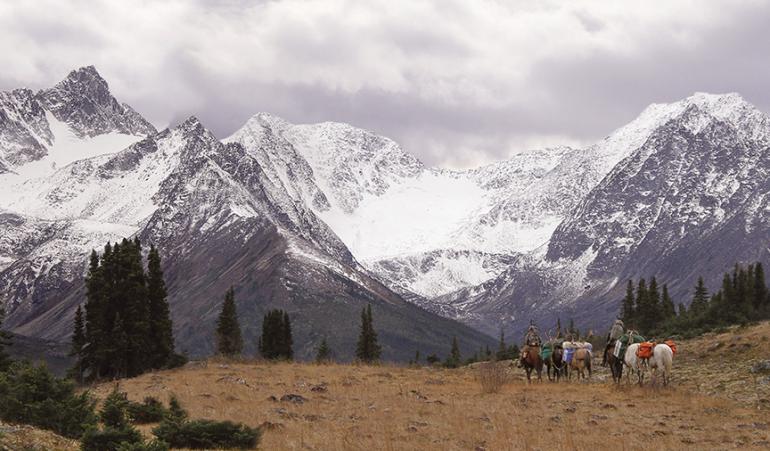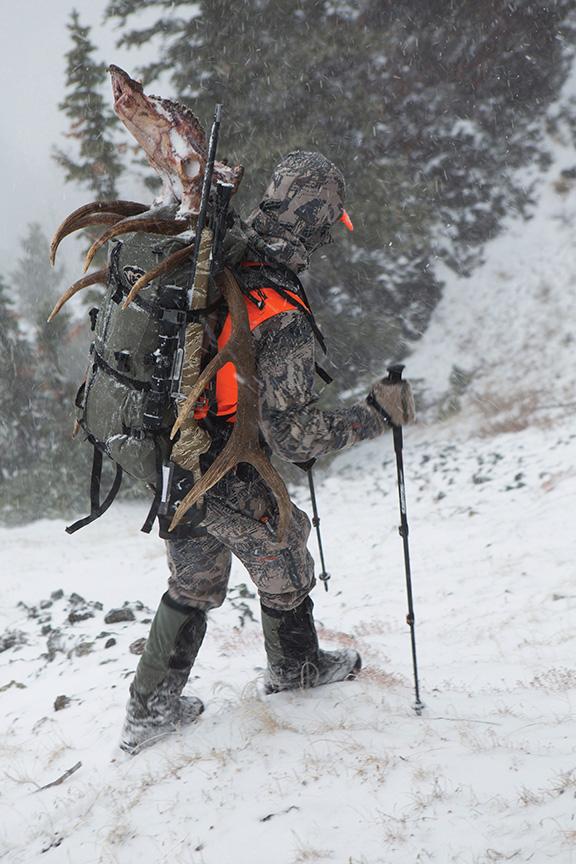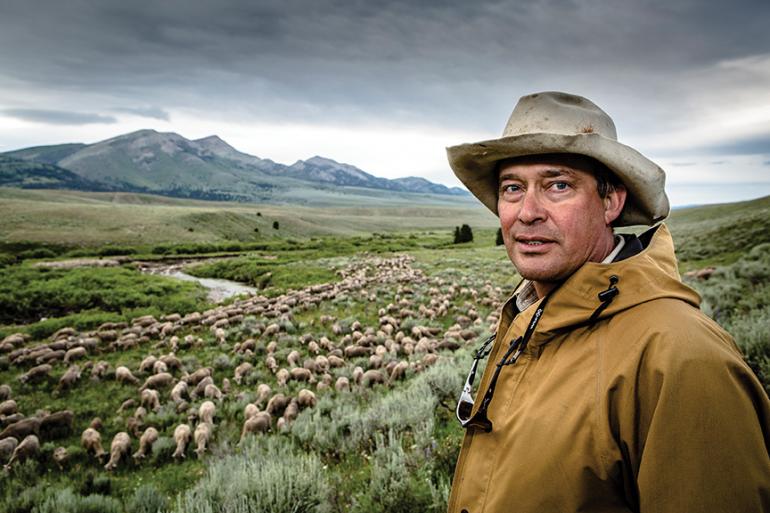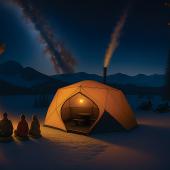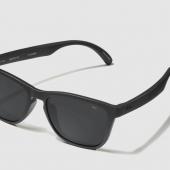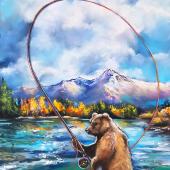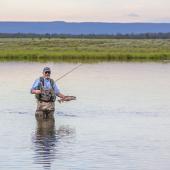Outdoor Entrepreneurs
Homegrown businesses flourish.
To the uninitiated, fall hunting conjures images of golden aspen, bulging elk, and snowcapped peaks. But we Montanans know better. The reality is sitting in cold sleet, bushwacking through dense underbrush, and packing heavy animal quarters down less-than-ideal mountain trails. We know the importance of a warm wool shirt, sturdy boots, and a reliable backpack—which is why it’s no surprise that Duckworth Wool, Kenetrek Boots, and Stone Glacier Packs are Bozeman-born companies that feed off the community’s insatiable quest for wild game and the environments in which they live.
Stone Glacier Packs: Into the Alpine
“My best day in the field would have to be sheep hunting in the alpine,” says Stone Glacier founder and owner Kurt Racicot. “It begins with a tough approach where you earn your view once you finally get up there,” he explains. “You’re able to locate animals and enjoy time up there, getting to watch them for awhile. It certainly doesn’t have to end in filling a tag—some of the best days I have don’t.”
Hunting away from roads and access points isn’t every hunter’s idea of a good time, but Racicot isn’t the average hunter. When you aren’t the average hunter, you aren’t satisfied with the average backpack—which is precisely what inspired him to start Stone Glacier in 2012. Like many Montanans, Racicot began hunting with his father, a high-school teacher and football coach. Racicot grew up outside of Frenchtown and describes his autumns as “school and football all week and hunting all weekend.” After graduating from Montana State, he moved to Alaska, where he learned to appreciate a true backcountry hunt.
Racicot began his quest for the perfect minimalist hunting pack by gutting backpacks and adding his own features to make them lighter and more durable. Racicot’s background in welding and construction gave him an eye for design, especially when he realized that “fabric construction paralleled steel and aluminum construction.” He bought a sewing machine, taught himself to sew, and began creating and testing pack designs during his alpine hunts. Mutual friends and acquaintances started showing interest. He had a small batch of packs sewn, sunk all the profits into the next round of production, and Stone Glacier was born. Racicot’s passion for “country that doesn’t see many people” grew when he returned to southwest Montana, and the local hunting crowd has been crucial to his company’s growth. “The Bozeman community has been a huge part of getting the design where it is today. Through business, we’ve made a lot of good friends in the community that have had really good input about the direction and type of things we can do with our packs.”
Duckworth Wool Company: It’s Radical
“Our sheep? They wake up, get a massage, go to the spa, and then we clip their toenails. They take a little walk on a sunny mountainside, and eat some grass,” Robert Bernthal, President of Duckworth Wool Company, explains with a laugh. Albeit exaggerated, Bernthal’s description isn’t far from the truth. The merino sheep on the Helle Rambouillet ranch near Dillon do live the good (sheep) life and are the first step in one of the world’s smallest commercial textile production chains. Duckworth is the joint project of three men whose appreciation of wool stems from different interests. Bernthal, with a background in sports marketing, brought branding and commercial experience to Duckworth. John Helle, a fourth-generation rancher and wool producer, manages the sheep ranch outside Dillon. Graham Stewart, who Bernthal describes as the “world’s leading wool-textile technician” develops and tests fabrics and designs.
“It was just a matter of going skiing,” says Bernthal, explaining the first Duckworth meeting in 2012. “We’re all the same age, from the same generation of ski bums. We’re outdoorsmen, we’re hunters, and we’re skiers, so I said, ‘Hey, let’s see if we can do this.’” Three chairlifts into a day at Maverick Mountain and Duckworth was born.
Throughout our conversation, Bernthal referred to Duckworth as “radical.” As he explained Duckworth’s mission and process further, I realized he wasn’t using language leftover from his ski-bum days—the company is actually trying to reform and change the way we think about our basic textile systems. The majority of high-performance merino wool is produced in Australia or New Zealand, then shipped to Asia for processing. Popular outdoor brands buy already-made fabric to incorporate into their designs. Duckworth is taking their wool from sheep to fabric to final design, all within the United States. The company has revitalized old machinery and an old southern tradition of textile production, allowing them full control over every step of the process.
The Bozeman community has heavily influenced the Duckworth product. “In Bozeman, we need clothes that perform,” Bernthal explains. “For hunting season, they have to work for long, cold days, and often for several days in a row. Our clothes are built for this environment.” Wool, due to its chemical reaction with human skin, is the perfect fiber for outdoorsmen. “Plus, it doesn’t stink,” he adds, “which is always a good thing.”
Looking to the future, Bernthal and the Duckworth Company are working to create a Montana wool collective to advocate for Montana-sourced textiles. “When you buy a Duckworth product, you also support Montana because you’re supporting ranchers. You’re supporting this small community life that a ranch brings to a town like Dillon.”
Kenetrek Boots: Knowledge of a Long Journey
A backcountry hunter’s most important tool may not be his weapon, but more likely what he wears on his feet. Or at least that’s what the supportive customers of Kenetrek Boots believe.
“When our customers find our boot, they typically fall in love with it and say things like ‘the only time I take ‘em off is when I shower,’” Kenetrek founder Jim Winjum says with a chuckle. “They just become addicted to them, because they’re a beautifully comfortable boot that performs in extreme environments.”
In 2005, after a 20-plus-year career with a locally-based shoe company, Winjum decided to try his hand at a company of his own. Much of his inspiration for the Kenetrek boots has come directly from his outdoor experiences around Montana and Alaska. “We have a love for these adventurous hunting and backpacking expeditions. It’s brutal. You’re getting dropped off, you’re completely out of touch with everybody,” he reflects. “I have bad feet. I would’ve been better off taking up something like knitting, but it wasn’t in the cards for me.” Instead, Winjum focuses on making lines of the most comfortable and tough boots he can. Repairing over 10,000 boots a year helps the company understand why and how the boots wear out. Winjum and his team are constantly redesigning and adjusting to continue making the Kenetrek boots the best they can be.
“My deepest appreciation is for quality products. I can’t stand products that don’t work,” he says. In addition to refining the existing lines of mountain, pac, and hiking boots, Kenetrek is also exploring a boot market that no one else has, designing orthopedic boots with built-in braces for post-injury or post-operation users. They’ve also released a line of high-performance socks, because as Winjum explains, “that just makes sense.”
Winjum explains that “Ken” is a Scottish term for “knowledge of,” while a “trek” is a long journey. Customer testimonials and a rapidly growing business indicate that he’ll be on this journey for the long haul.


